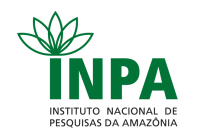Corpo Discente - Egressos
Dorothy Ivila de Melo Pereira
| Título | ISOLAMENTO DE FUNGOS ENDOFÍTICOS DE Arrabidaea chica (BIGNONIACEAE) E BIOPROSPECÇÃO DE ESPÉCIES PRODUTORAS DE PIGMENTOS | ||||||||||||||||||||||||
| Data da Defesa | 22/03/2024 | ||||||||||||||||||||||||
| Download | Em sigilo | ||||||||||||||||||||||||
Banca
| |||||||||||||||||||||||||
| Palavras-Chaves | Arrabidaea chica; fungos endofíticos; Hypoxylon investiens; pigmentos | ||||||||||||||||||||||||
| Resumo | Os pigmentos extraídos de fungos representam uma alternativa promissora aos corantes sintéticos, destacando-se por sua versatilidade em diversas aplicações industriais e por suas propriedades seguras e ecologicamente sustentáveis. Além da capacidade de coloração, muitos desses pigmentos fúngicos são reconhecidos por suas propriedades antimicrobianas, antioxidantes e citotóxicas, ampliando ainda mais seu potencial de aplicação. Os microrganismos endofíticos, provenientes de plantas amazônicas como a Arrabidaea chica, tornam-se uma valiosa fonte de compostos bioativos com diversas aplicações biotecnológicas, incluindo os pigmentos. Neste contexto, o presente estudo teve como objetivo isolar e identificar fungos endofíticos presentes nas partes aéreas da planta medicinal A. chica, a fim de selecionar fungos produtores de pigmento. Adicionalmente, buscou-se estudar as condições de cultivo que favorecessem a produção dos metabólitos desejados, avaliar atividades biológicas nos extratos pigmentados e caracterizar quimicamente as moléculas de pigmento produzidas. Foram isolados 121 fungos filamentosos de folhas e galhos de três arbustos da variedade II de A. chica, identificados geneticamente como pertencentes a diversos gêneros, como: Aspergillus, Colletotrichum, Cophinforma, Coprinellus, Curvularia, Diaporthe, Hypoxylon, Muscodor, Muyocopron, Neoscytalidium, Odontoefibuela, Paecilomyces, Penicillium e Phyllosticta. Inicialmente esses isolados foram avaliados em uma triagem em meio sólido (BDA) para produção de pigmentos. Após essa triagem, nove fungos incluindo A. welwitschiae CG2-7, A. sydowii CF1-3, D. cerradensis – CG2-4 e CG2-12, H. investiens CF1-37, P. rubens CG2-5, Neoscytalidium sp. – CG1-2 e CG2-10, e Curvularia sp. CF3-5, foram submetidos a fermentação submersa em dois meios de cultura para obtenção de extratos metabólicos. A análise da absorbância entre 400 e 700 nm revelou que o extrato pigmentado produzido por H. investiens CF1-37 em meio contendo extrato de levedura apresentou máxima absorbância na faixa vermelha (UA700 = 0,550) sendo selecionado para o estudo das condições de cultivo por meio de um planejamento experimental. As condições ideais para a produção do pigmento verde-amarelado produzido pelo isolado H. investiens CF1-37 foram otimizadas por meio de um planejamento experimental do tipo DCCR, considerando duas variáveis-chave: temperatura e tempo de cultivo. A máxima eficiência na produção do pigmento foi alcançada nas condições de 25,5 ºC e um tempo de cultivo de 17,5 dias. A análise da estabilidade do extrato pigmentado revelou uma coloração estável no meio de cultivo contendo batata portuguesa (200 g/L), dextrose (10 g/L) e extrato de levedura (2,0 g/L) a pH 4,0, além de significativa atividade antioxidante e antimicrobiana. A análise química do extrato pigmentado destacou a presença de compostos fenólicos e flavonoides. Diante dos resultados obtidos, conclui-se que o isolado H. investiens CF1-37 possui um potencial promissor como uma nova fonte de pigmentos, com possíveis aplicações industriais. | ||||||||||||||||||||||||
| Abstract | The pigments extracted from fungi represent a promising alternative to synthetic dyes, standing out for their versatility in various industrial applications, and their safe and environmentally sustainable properties. In addition to their coloring ability, many of these fungal pigments are recognized for their antimicrobial, antioxidant and cytotoxic properties, further expanding their potential applications. Endophytic microorganisms from Amazonian plants, such as Arrabidaea chica, emerge as valuable sources of bioactive compounds with diverse biotechnological applications, including pigments. In this context, the present study aimed to isolate and identify endophytic fungi in the aerial parts of the medicinal plant A. chica to select pigment-producing fungi. Additionally, the study sought to investigate cultivation conditions favoring the production of the desired metabolites, to evaluate biological activities in the pigmented extracts, and chemically characterize the produced pigment molecules. A total of 121 filamentous fungi were isolated from leaves and branches of three shrubs of A. chica variety II, genetically identified as belonging to various genera, including Aspergillus, Colletotrichum, Cophinforma, Coprinellus, Curvularia, Diaporthe, Hypoxylon, Muscodor, Muyocopron, Neoscytalidium, Odontoefibuela, Paecilomyces, Penicillium, and Phyllosticta. Initially, these isolates were screened on solid medium (BDA) for pigment production. Following this screening, nine fungi, including A. welwitschiae CG2-7, A. sydowii CF1-3, D. cerradensis – CG2-4 and CG2-12, H. investiens CF1-37, P. rubens CG2-5, Neoscytalidium sp. – CG1-2 and CG2-10, and Curvularia sp. CF3-5, were subjected to submerged fermentation in two culture media to obtain metabolic extracts. Analysis of absorbance between 400 and 700 nm revealed that the pigmented extract produced by H. investiens CF1-37 in medium containing yeast extract exhibited maximum absorbance in the red range (UA700 = 0.550) and was selected for the study of cultivation conditions using an experimental design. The optimal conditions for producing the greenyellow pigment by the H. investiens CF1-37 isolate were optimized through a DCCR experimental design, considering two key variables: temperature and cultivation time. The maximum efficiency in pigment production was achieved at a temperature of 25.5 ºC and a cultivation time of 17.5 days. The analysis of the stability of the pigmented extract revealed stable coloring in the culture medium containing white potato (200 g/L), dextrose (10 g/L), and yeast extract (2.0 g/L) at pH 4.0, along with significant antioxidant and antimicrobial activity. Chemical analysis highlighted the presence of phenolic compounds and flavonoids in the pigmented extract. Based on the results obtained, it can be concluded that the H. investiens CF1-37 isolate holds promising potential as a new source of pigments with potential industrial applications. | ||||||||||||||||||||||||
Parceiros

























